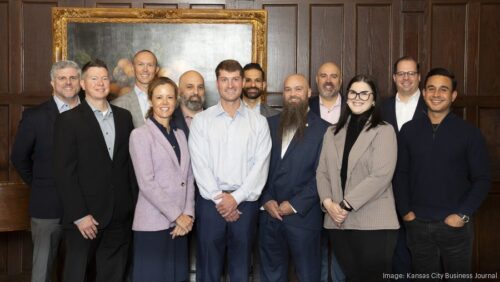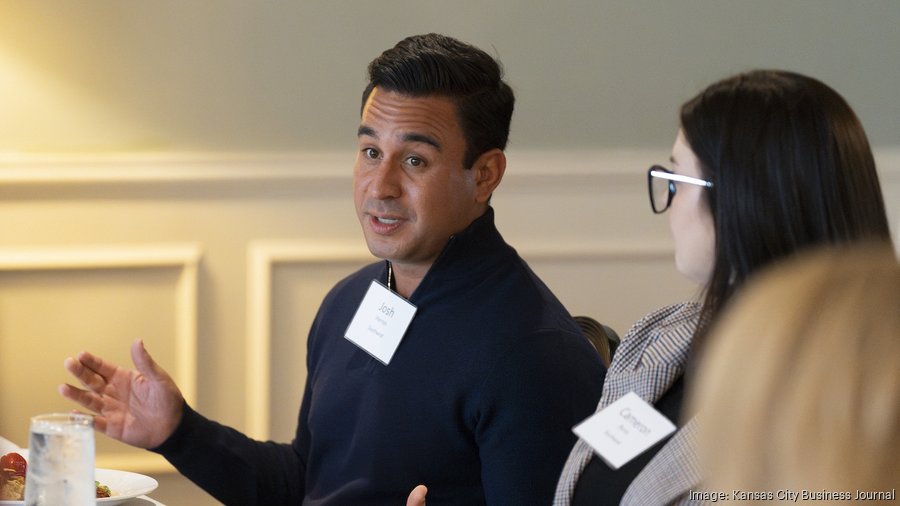
ADAM VOGLER I KCBJ
11.2.23 – Business Journals
Artificial intelligence has captured the modern imagination — for better and worse. Speculation abounds as various sectors try to extrapolate their AI-influenced futures. Schools are considering policies about student use of AI chatbots, such as ChatGPT. Medical professionals tout disease-fighting possibilities. Some warn of threats and, recognizing the vast potential for good or harm, federal lawmakers are grappling with how to regulate this rapidly evolving corner of technology.
Kansas City-area business leaders recently gathered at a roundtable sponsored by Bank of Blue Valley, a division of HTLF Bank, to discuss the potential pros and cons of generative AI, which has learning and predictive capabilities.
While it’s difficult to forecast specifics, a few things are clear: Generative AI will bring changes in operations, jobs and customer experience, offering vast potential for efficient data analysis and handling of repetitive or mundane tasks. Just as with dramatic technological shifts throughout history, there will be risks and unintended consequences.
Ultimately, users can’t rush in blindly, panelists said.
“You’ve got to understand what the business outcome is before you’re looking for technology because you’ll drown in the amount of technology that’s out there,” said Matt Tyler, vice president of strategic innovation and business development for Wachter Inc., a nationwide systems integrator and technology deployment company. “If you don’t know what the problem is, you’ll never solve it with technology.”
Trying AI on for size
Companies have long relied on technology to fuel growth, and the predictive automation enabled by generative AI offers many conceivable efficiencies, such as in customer service, writing job descriptions, risk mitigation, or data analysis that can lead to better decision-making. However, specific applications vary widely across industries.
Zack Donnelly, director of business development for Lenexa-based John A. Marshall Co., said that the commercial office furnishing, flooring and architectural product dealer uses generative AI to quickly produce a variety of potential floor plans for clients who are evaluating multiple office spaces. The tool helps clients make the right real estate investment decisions, he said.

Lenexa-based Southwind operates several home services companies with locations across the country and into Canada; it has used AI to help automate portions of marketing and customer service. For its moving company, You Move Me, AI has been particularly helpful in estimating, said Southwind CEO Josh Herron. An AI technology picks up item size, weight and inventory, generating more accurate estimates about moving time, truck space and costs.
“We’re trying to take the surprises out of the moving space,” Herron said.
Likewise, sports and entertainment ticket marketplace TFL Group hopes to harness the data analysis potential of AI. Understanding average ticket price trends and why events go up and down promises to help the company make sound business decisions into the future, and AI also can help train young engineers as they write scripts or codes, said Chief Technology Officer Brian Leftwich.
Henderson Engineers, based in Lenexa, appreciates the efficiencies of AI, such as automating repetitive tasks so engineers can think more deeply and work more with customers, said CEO Kevin Lewis. The architectural engineering and construction industry is moving toward more applications that could change the way work looks into the future, he said.

Wachter both consumes AI and is implementing it for customers, Tyler said.
“With so many different manufacturers of these technologies, keeping our workforce trained and up to date on all the new stuff that’s coming out is a challenge for us,” he said. “So a realization of augmented reality in conversational AI allows us to push knowledge bases to our technicians and electricians in the field.”
The tool helps walk employees through the process of service or maintenance, yielding lower costs and a better experience for customers because they’re always getting the right person at the right time, Tyler said.
For creative organizations, such as travel and hospitality advertising agency MMGY Global, AI augments human-centric creativity, said Robert Patterson, senior vice president for marketing technology. Operational efficiencies and tools such as chatbots have proven useful during the past several years; now the company is evaluating how to leverage data, including creating closed-loop systems for proprietary research.
For industries facing labor shortages, such as construction, AI can help bridge the experience gap, said Dustin Burns, vice president of information technology for Kansas City-based McCownGordon Construction. Due to the tight labor market, employees may end up in senior positions more quickly than in the past, so generative AI can provide them with information to help get them up to speed as rapidly as possible. Burns dubbed it as a “co-pilot” experience — for example, if they have limited experience with contract language, the tool can help them understand a contract and what to do in certain situations.
Lewis of Henderson Engineers said AI also can help limited numbers of employees accomplish more, and it also can supplement staff. For example, using cameras to inspect elements such as materials, ductwork or piping can mean not having to send a person to a site, benefitting both the company and clients.
In addition, AI can help with risk mitigation, panelists said. It can be used to detect safety hazards and provide warnings on construction sites, to stop machines, to track company drivers for safety, or to alert retailers about crime patterns.
AI also has the potential to help organizations understand their clients and industry trends, particularly in sectors where customers are difficult to reach and applications are widespread, said Laura McConnell, CEO of laboratory equipment maker Labconco.
“It’s an interesting opportunity to try to stay on top of research trends,” she said.
Evaluating the risks
Even as they recognize tremendous potential, business leaders are approaching AI cautiously. Among the chief concerns: privacy, data security and control. There’s also concern about potential effects on the labor force.
“I think there’s going to be a lot of parameters put in place at each company to kind of come up with the processes to keep them safe and operating functionally; how that looks, I do not know yet,” said Donnelly.
MMGY Global has assembled an AI taskforce to evaluate potential applications and effects, Patterson said.
“We’re really proponents of testing and allowing exploration with our associates,” he said. “But we felt it was really important for us to get an AI policy in place that gave some guardrails to our associates.”
That included making sure employees knew which tools could put proprietary client or company data at risk of public exposure.
Using ChatGPT to review a contract, for example, may look like a good idea on TikTok, but it could put intellectual property at risk, Tyler said.
While AI insights can be informative, they can’t replace human intervention for evaluations such as loans, said Chris Bannister, head of commercial banking for Bank of Blue Valley.
In financial services, one thing to be very mindful of — and very key to any decisions being made — is the protection of clients’ information. Any AI strategies must evaluate maximizing the benefits in a way that never risks AI memorizing confidential data or releasing it publicly.
Companies also recognize they must keep tabs on AI aids, whether in employee training or making business decisions.
The employment impact is difficult to judge, panelists said. AI probably will mean job redundancies for certain functions, but it’s also likely to generate parallel jobs — such as in fraud detection and prevention, or regarding how best to integrate advancing AI technologies. Employees could be shifted into new roles as job descriptions change.
As much potential as AI offers, companies can’t neglect training, Herron said.
“That tool is only going to be as good as the people who are leveraging it,” he said.
Ultimately, AI tools that are widely available won’t differentiate one company from a competitor. For example, ChatGPT is a great resource, but “it’s the same cookie-cutter response for everything that you have,” said Cameron Burns, director of marketing for Southwind.
“So if you’re leveraging it, your competition is going to be leveraging it, and then our value proposition is the exact same across the board,” she said. “So taking what is going to work for us, but only using that as a resource and not having that be the final end product is going to help us continue to grow and evolve, as well.”
Technology, business and government leaders seem to have learned from the unintended consequences of social media and are being more cautious regarding AI, Patterson said.
“There’s just a lot of inherent risks and unknowns that we need to pay attention to,” he said.
